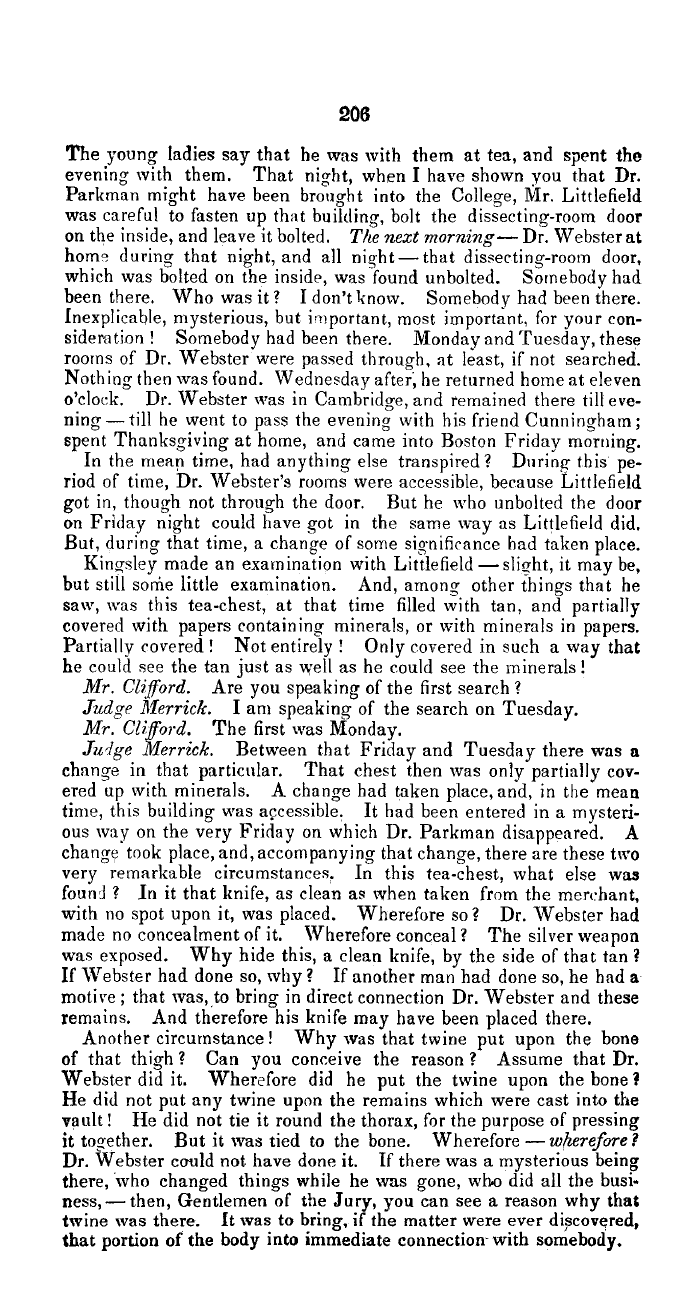|
206
The young ladies say that he was with them at tea, and spent the
evening with them. That night, when I have shown you that Dr.
Parkman might have been brought into the College, Mr. Littlefield
was careful to fasten up that building, bolt the dissecting-room door
on the inside, and leave it bolted. The next morning-Dr. Websterat
home during that night, and all nio-ht-that dissecting-room door,
which was bolted on the inside, was found unbolted. Somebody had
been there. Who was it? I don't know. Somebody had been there.
Inexplicable, mysterious, but important, most important, for your con-
sideration ! Somebody had been there. Monday and Tuesday, these
rooms of Dr. Webster were passed through, at least, if not searched.
Nothing then was found. Wednesday after; he returned home at eleven
o'clock. Dr. Webster was in Cambridge, and remained there till eve-
ning -till he went to pass the evening with his friend Cunningham;
spent Thanksgiving at home, and came into Boston Friday morning.
In the mean time, had anything else transpired? During this pe.
riod of time, Dr. Webster's rooms were accessible, because Littlefield
got in, though not through the door. But he who unbolted the door
on Friday night could have got in the same way as Littlefield did.
But, during that time, a change of some sio-nificance had taken place.
Kingsley made an examination with Littlefield -slight, it may be,
but still some little examination. And, among other things that he
saw, was this tea-chest, at that time filled with tan, and partially
covered with papers containing minerals, or with minerals in papers.
Partiallv covered ! Not entirely ! Only covered in such a way that
he could see the tan just as well as he could see the minerals!
Mr. Clifford. Are you speaking of the first search ?
Judge Merrick. I am speaking of the search on Tuesday.
Mr. Cliford. The first was Monday.
Jclge Merrick. Between that Friday and Tuesday there was a
change in that particular. That chest then was only partially cov-
ered up with minerals. A change had taken place, and, in the mean
time, this building was accessible. It had been entered in a mysteri-
ous way on the very Friday on which Dr. Parkman disappeared. A
change took place, and, accompanying that change, there are these two
very remarkable circumstances, In this tea-chest, what else was
foun ? In it that knife, as clean as when taken from the merchant,
with no spot upon it, was placed. Wherefore so? Dr. Webster had
made no concealment of it. Wherefore conceal ? The silver weapon
was exposed. Why hide this, a clean knife, by the side of that tan?
If Webster had done so, why ? If another man had done so, he had a
motive; that was, to bring in direct connection Dr. Webster and these
remains. And therefore his knife may have been placed there.
Another circumstance! Why was that twine put upon the bone
of that thigh ? Can you conceive the reason ? Assume that Dr.
Webster did it. Wherefore did he put the twine upon the bone?
He did not put any twine upon the remains which were cast into the
vault! He did not tie it round the thorax, for the purpose of pressing
it together. But it was tied to the bone. Wherefore -wherefore?
Dr. Webster could not. have done it. If there was a mysterious being
there, who changed things while he was gone, who did all the busi-
ness,-then, Gentlemen of the Jury, you can see a reason why that
twine was there. It was to bring, if the matter were ever discovered,
that portion of the body into immediate connection with somebody.
|

